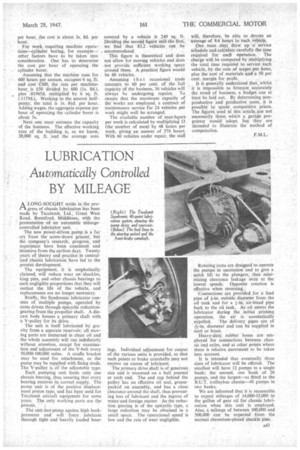LUBRICATION
Page 57

If you've noticed an error in this article please click here to report it so we can fix it.
Automatically Controlled
BY MILEAGE
A LONG-SOUGHT stride in the pro
gress of chassis lubrication has been made by Tecalemit, Ltd., Great West Road, Brentford, Middlesex, with the presentation of an automatic mileagecontrolled lubricator unit. .
The new power-driven pump is a far cry from the screw-down greaser, but the company's research, progress, and experience have been consistent and intensive from the earliest days. Twenty years of theory and practice in centralized chassis lubrication have led to the present development.
The equipment, it is emphatically claimed, will reduce wear on shackles, king pins, and other chassis bearings to such negligible proportions that they will outlast the life of the vehicle, and replacements are no longer necessary.
Briefly, the Syndromic lubricator consists of multiple pumps, operated by earns driven through epicyclic reductiongearing from the propeller shaft. A diecast body houses a primary shaft with a V-pulley for its drive.
The unit is itself lubricated by gravity from a separate reservoir; all mov ing parts are immersed in clean oil and the whole assembly will run indefinitely without attention, except for examina tion and adjustment of the V-belt every 50,000-100.000 miles. A cradle bracket may be used for attachment, or the pump may be supplied with fixing studs.
The V-pulley is of the adjustable type. Each pumping unit feeds only one chassis bearing, thus assuring that every bearing receives its correct supply. The pump unit is of the positive displacement piston type, and has been used for Tecalemit aircraft equipment for some years. The only working parts are the pistons. , The unit can pump against high backpressures and will force lubricant through tight and heavily loaded bear ings. Individual adjustment for output of the various units is provided, so that such points as brake camshafts may not receive an excess of lubricant.
The primary drive shaft is of generous size and is mounted, on a ball journal at each end. The end cap behind the pulley has an effective oil seal, greasepacked on assembly, and has a close clearance around the shaft, thus preventing loss of lubricant and the ingress of water and foreign matter. As the reduction gearing is of the epicyclie type, a large reduction may be obtained in a small space. The operational speed is low and the rate of wear negligible.
Rotating cams are designed to operate the pumps in succession and to give a quick lift to the plungers, thus minimizing clearance leakage even at the lowest speeds. Opposite rotation is effective when reversing.
Connections are provided for a feed pipe of fin, outside diameter from the oil tank and for a air-bleed pipe back to the oil tank. As oil enters the lubricator during the initial priming operation, the air is auomatically cinched. The delivery pipes are of " diameter and can be supplied in steel or bras's.
Heavy-duty_ rubber hoses are employed for connections between chassis and axles, and at other points where there is relative movement to be taken into account.
It is intended that eventually three sizes of lubricator will be offered. The smallest will have 12 pumps in a single bank; the second, one bank of 20 pumps, and the largest—as fitted to the B.U.T. trolleybus chassis-40 pumps in two banks.
We are informed that it is reasonable to expect mileages of 14,000-15,000 to the gallon of gear oil for chassis lubrication when this unit is employed. Also, a mileage of between 100,000 and 300,000 can be expected from the normal chromium-plated shackle pins.
















































































